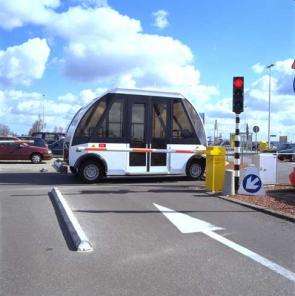Driverless transport in big cities

While traffic problems in major cities have been familiar for a long time, the measures needed to deal with them have still to be put into effect. However, in its 6th Framework Programme, the EU is beating the big drum and looking for more efficient transport solutions in big cities, as well as more rational use of motor traffic. New traffic solutions such as completely automated vehicles moving on tracks, cars in defined corridors (cybercars) and bi-modal vehicles that can alternate between automatic and manual control, will aim to reduce traffic queues and pollution.
“This may sound like pure science fiction,” says senior scientist Torgeir Vaa at SINTEF (Norway), “but the technology already exists and a number of demonstrations and pilot studies in this area have already been carried out, and these show that the systems do work. In the future that we are talking about, private cars will have to park at the city limits, and other systems will take over in the centre. This means that there will be a need for rapid public transport systems (buses, trains, underground) and personal transport for short distances.
Heathrow Airport, a new exhibition centre in Rome and the Spanish city of Castellón are the sites that have been selected to demonstrate and confirm the viability of automated transport solutions. When the CityMobil project comes to an end in five years, these sites will have installed fully developed automated transport systems, and the first results will have been evaluated.
The Spanish city of Castellón will adopt bimodal buses that are capable of operating both manually and automatically – depending on where they are. In the new exhibition centre in Rome, a fleet of fully automated cybercars will be part of the fleet of vehicles that carry people between the car park, the railway station and the exhibition centre, while Heathrow will have a transit system that will carry people between the terminal and the car park in fully automated vehicles running on tracks.
From private motoring to public transport
Until now, advanced high technology has made most progress in private cars, where the introduction of ADAS (Advanced Driver Assistance Systems) has improved driving comfort. ADAS refers to support systems that prevent the driver from exceeding the speed limit by making the accelerator pedal “heavy”, or that ensure that cars keep a safe distance from the vehicle ahead in a traffic queue.
CityMobil is a prolongation of the EU’s earlier Stardust project, in which SINTEF was also involved, and which built demonstration vehicles with ADAS technology that are in use today in the 0 Vision project in Lillehammer and in Trondheim City Operation.
Now, the EU wishes to focus on public transport, where little has been done, with the exception of a few automated metro systems (Paris, London, Lille) and some recently introduced automated buses and small units (Rouen, Eindhoven).
The SINTEF scientists regard it as extremely important to be members of the powerful EU consortium that comprises Europe’s total expertise in this area, with the Netherlands’ TNO in the driving seat, as it were. This large-scale European project consists of five sub-projects, and SINTEF will be involved in two of these, on tasks that include payment systems and safety legislation and regulations.
“Imagine that you arrive at Heathrow and want to get from the car park to the terminal”, say Vaa. “You call up an automatic driverless unit that is circulating and comes to the spot where you are parked. But what about personal protection and safety aspects? What about other people who are standing at the same parking place? Another example concerns driverless vehicles in mixed traffic; who would be responsible in the event of an accident?”
Trondheim has also been selected as a member of a reference group of 15 European cities that will submit relevant problems to CityMobil and test out technological solutions in the course of the project.
“Although Rome, Castellón and Heathrow are the major demonstration sites, plans and concepts will also be set out for a number of other cities, in order to help local authorities make decisions regarding automated transport systems,” says Vaa. “Some of these cities will also benefit from hosting small-scale demonstrations of automated vehicles. This will all depend on how active the individual cities are. Both the City of Trondheim and the Directorate of Public Roads are members of the reference group, and we hope to have the new transport solutions demonstrated in Trondheim and perhaps in other Norwegian cities as part of the project.”
The CityMobil project has a budget of € 40 million and involves 28 partners in 10 different countries.
Source: SINTEF





















